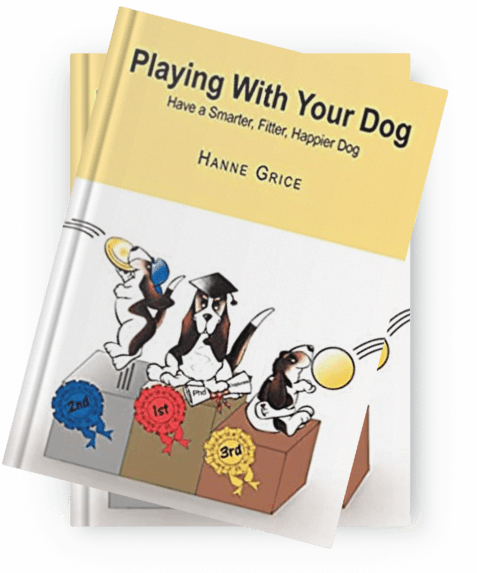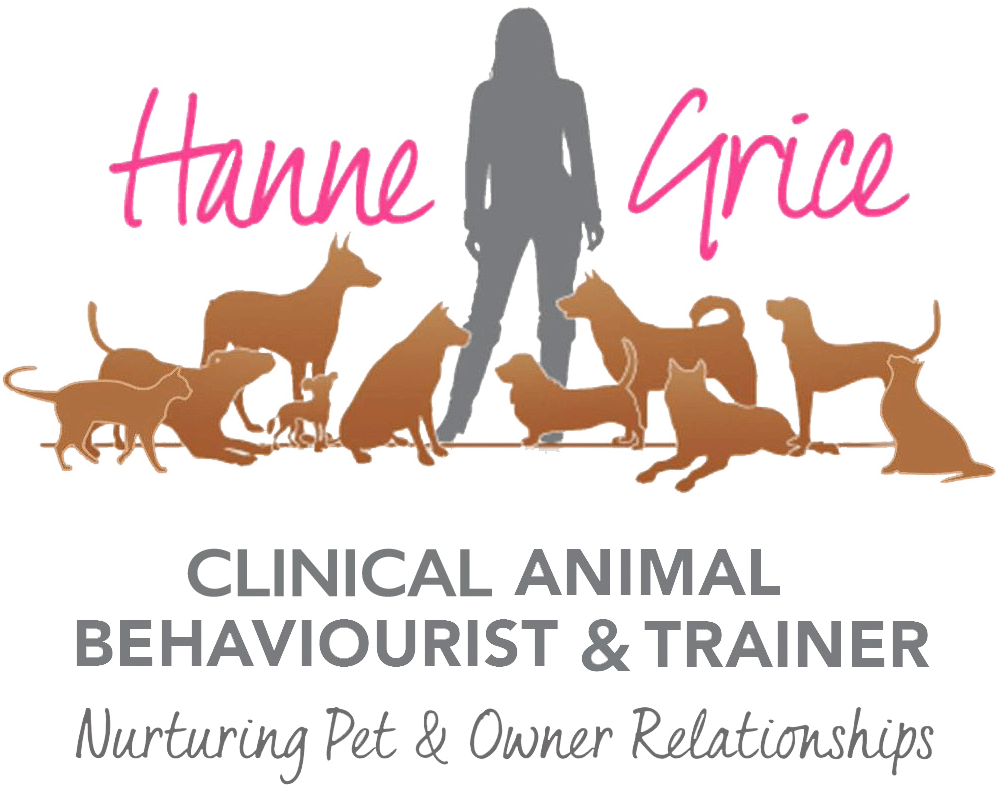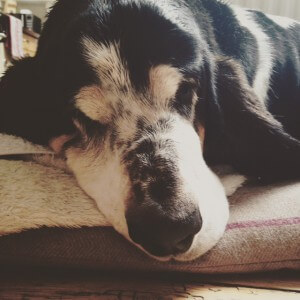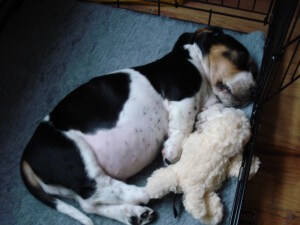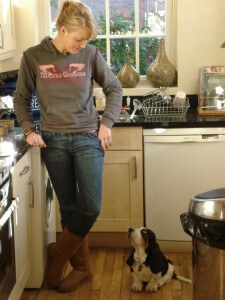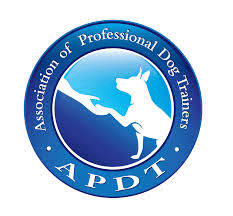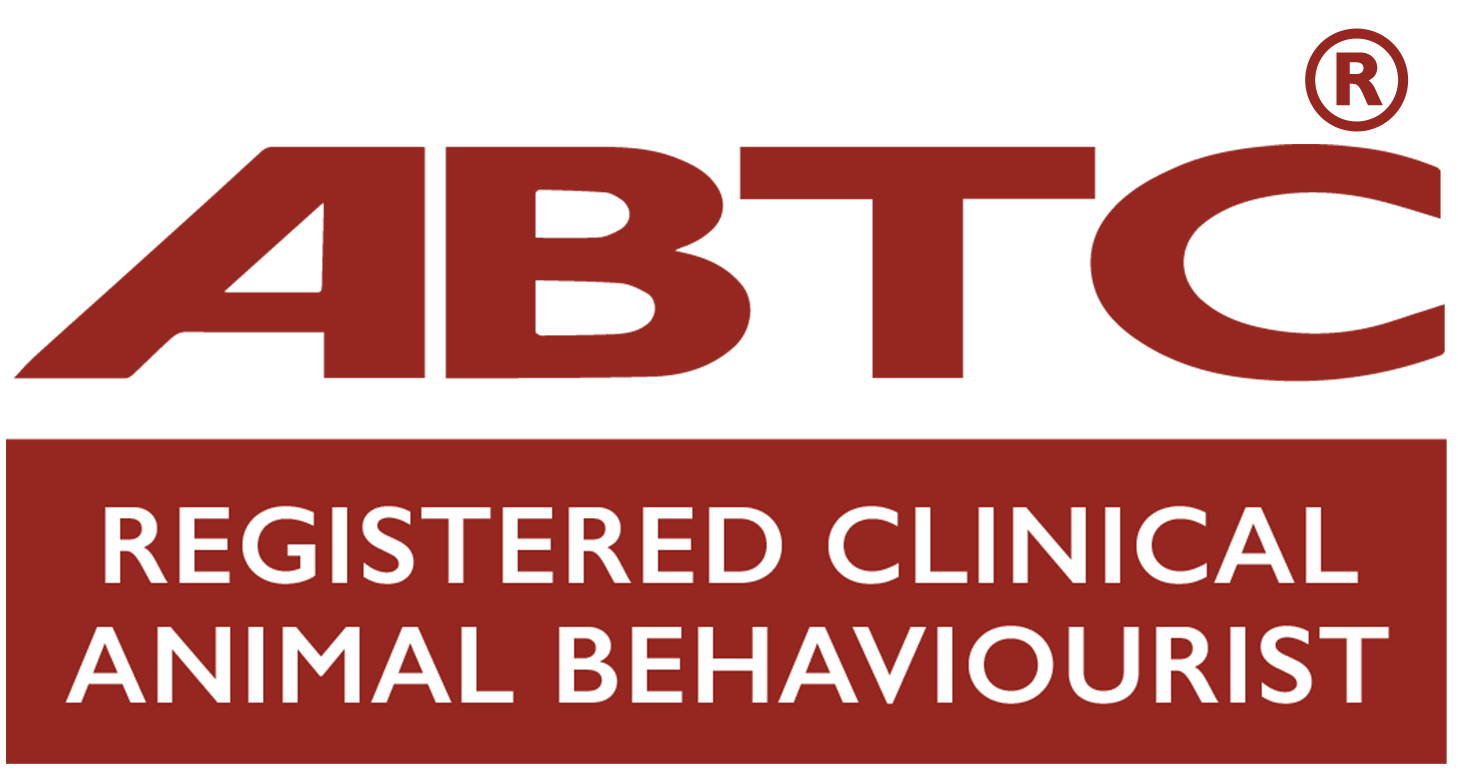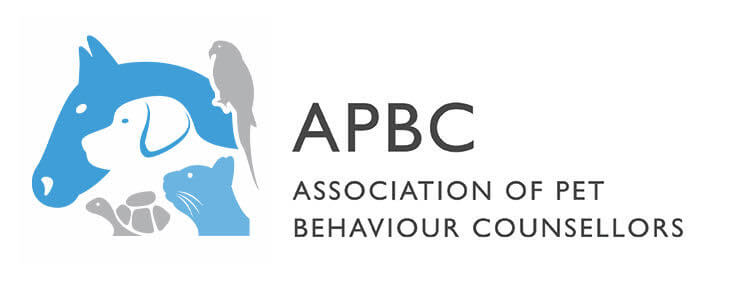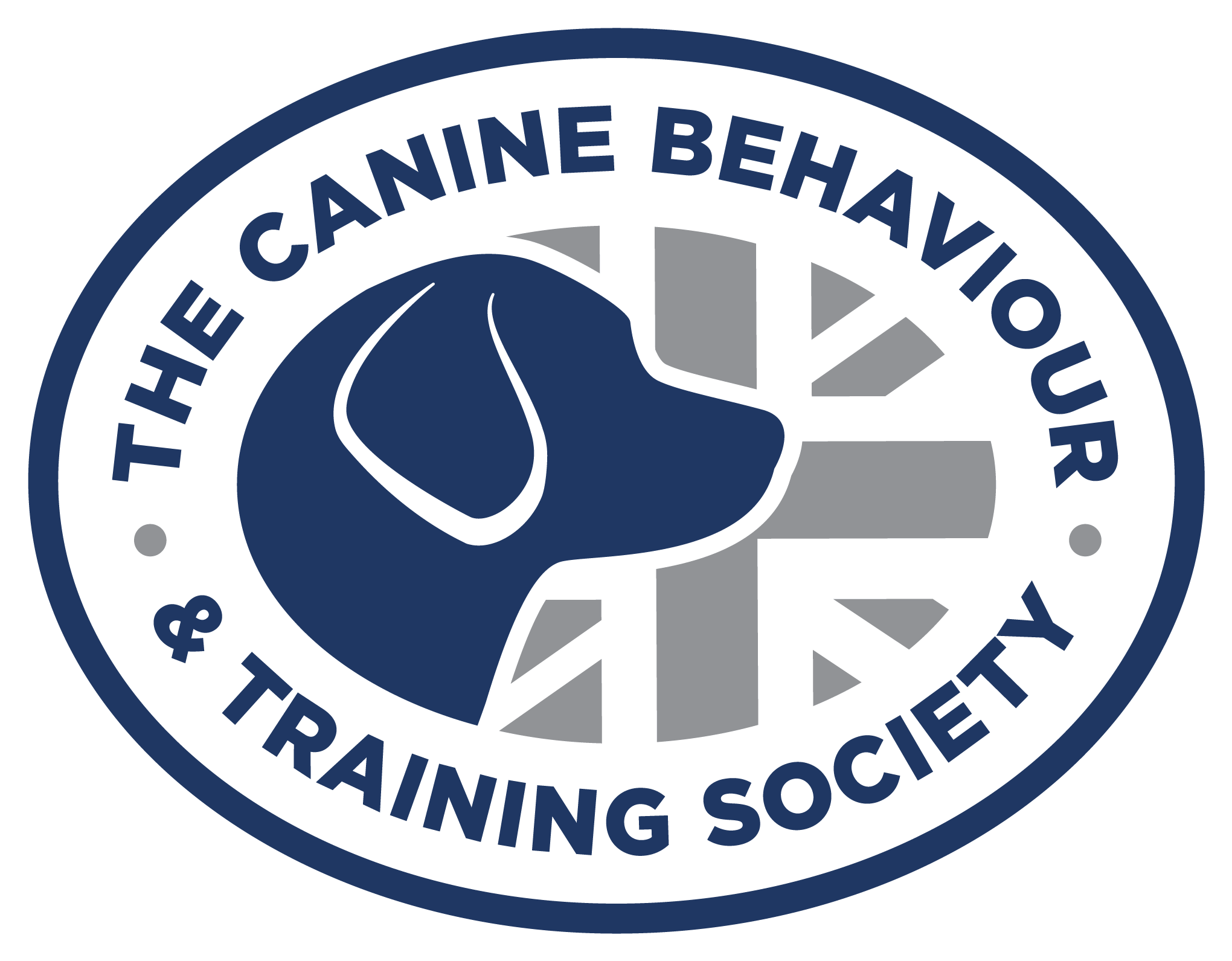As I write this post, my ageing Basset Hound Howard lays by my feet snoring. At 9 years of age, his muzzle has whitened, his eyebrows have greyed and he is noticeably stiff when he arises from his bed.
According to the Guinness Book of Records, the greatest reliable age recorded for a dog was an Australian cattle-dog called Bluey from Australia. He was 29.5 years old when he took his final nap on 14th November 1939. While this is a staggering age, most dogs live between 8 and 15 years. Typically, the larger the dog, the shorter the life span. The Irish Wolfhound, for example, is the tallest breed with a life expectancy of around 7 years, whereas a Jack Russell typically lives to around 14 years.
So, as I watch my Basset catching the ZZZ’s and twitching away, I’m reminded of my own stiffness and back pain which have all neatly coincided with my recent milestone of turning 40. And that folks, is all because the ageing process has similar effects on our dogs as it does us humans. Scroll down to fast track to the secrets of ‘slowing down’ the ageing process.
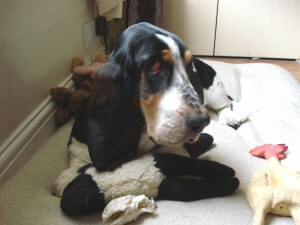 Dogs and humans age in similar ways
Dogs and humans age in similar ways
As we grow older, we begin to show signs of ageing much like our pets, yet how the ageing process effects a dog can differ from one to the next; the dog’s environment and way in which he has been cared for will have an impact on this.
As a dog grows older changes take place both mentally and physically from the effectiveness of his senses, joints and organs to the efficiency of Fido’s nervous system. Consequently, old age can affect a dog’s behaviour, thinking and personality.
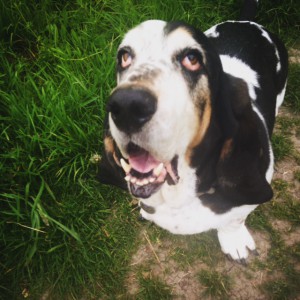 For many dogs, the physical signs of ageing are outwardly obvious from grey hairs and slower movement to grunting as they rise or lay down, due to the onset of arthritis – a painful inflammation and stiffness of the joints. Signs of arthritis include slowed movements, limping, or the dog reacting to being touched around certain joints. Dogs suffering from any discomfort or pain such as in the hip area, will also alter the way in which they stand or walk. Many dogs develop mobility problems and although all breeds are susceptible, the effect is typically much greater on larger dogs because of the weight they have to carry. It’s this loss of mobility due to changes in the dog’s joints and muscles that can cause the dog to seemingly change in his temperament. The reduced mobility and existence of pain can make an older dog irritable – particularly if disturbed or touched in the sensitive area. That’s because the dog’s natural response would be to move quickly away from a stressful situation but, with arthritis, that’s no longer an option.
For many dogs, the physical signs of ageing are outwardly obvious from grey hairs and slower movement to grunting as they rise or lay down, due to the onset of arthritis – a painful inflammation and stiffness of the joints. Signs of arthritis include slowed movements, limping, or the dog reacting to being touched around certain joints. Dogs suffering from any discomfort or pain such as in the hip area, will also alter the way in which they stand or walk. Many dogs develop mobility problems and although all breeds are susceptible, the effect is typically much greater on larger dogs because of the weight they have to carry. It’s this loss of mobility due to changes in the dog’s joints and muscles that can cause the dog to seemingly change in his temperament. The reduced mobility and existence of pain can make an older dog irritable – particularly if disturbed or touched in the sensitive area. That’s because the dog’s natural response would be to move quickly away from a stressful situation but, with arthritis, that’s no longer an option.
Ageing can also affect the dog’s organs, digestion, heart and lungs as they become less efficient and some dogs will even suffer from incontinence.
And, old age can affect the senses…
Some dogs may lose one or more of their senses; hearing, sight and even taste can be affected due to the onslaught of tooth decay and gum disease. Most dogs between the age of 12 to 15 years will show some evidence of hearing loss – it’s fairly common in older dogs as little bones in the ear (the ossicles) that transmit sound from the eardrum to the inner ear, begin to grind at their joints and lose their mobility in a similar way to arthritis. There are also tiny hairs cells that flex to register sounds in the inner ear (the cochlea) but over the years, repeated flexing causes a weakness in the connective tissue and the cells can break. These hair cells do not regenerate, so for every hair cell that is damaged, the dog loses a bit of its hearing ability.
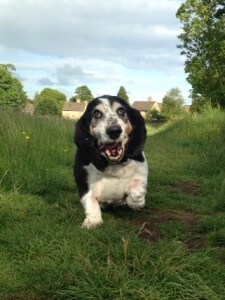 As a dog’s hearing begins to impair, like humans, they will become less sensitive to higher pitched notes; a dog will often appear to sleep through the sounds of a door bell ringing, loud bangs or may awake with a growl or snap if touched while sleeping, so these are things owners with older dogs need to watch for.
As a dog’s hearing begins to impair, like humans, they will become less sensitive to higher pitched notes; a dog will often appear to sleep through the sounds of a door bell ringing, loud bangs or may awake with a growl or snap if touched while sleeping, so these are things owners with older dogs need to watch for.
Clarity of sight diminishes with ageing, caused by a loss of retinal cells and elasticity in the dog’s lenses which hardens the tissue fibre, resulting in a fogginess on the eye and blurring eye sight. Because the eye takes longer to focus, owners may see a change in the speed at which their pet takes to recognise individuals or objects. You may also notice the eye starts to have a haziness or film appear over their eye (nuclear sclerosis) as the dog grows older. If this isn’t very thick, vision shouldn’t be impaired. Yet conditions such as glaucoma and cataracts can cause blindness. Cataracts look outwardly similar to nuclear sclerosis, and this condition can be hereditary – or – as a result of diabetes, injury, result of a poor diet, certain toxins and even exposure to ultraviolet light.
However, some vision can be restored through surgery, typically where the cataractous lens is removed and replaced with a plastic lens which stays in the eye permanently.
Ageing can impact the dog’s mind
The ageing process not only affects a dog’s sensory perception but it also causes changes mentally. Changes in the dog’s nervous system and in its hormone production can lead to a dramatic change in the dog’s behaviour. As the dog grows older the structure of the nerve cells in the brain start to break down, losing the dendrites and axon filaments that help transmit the flow of information from cell to cell. This affect is known as “pruning”. As a result the transmission of information from one place in the nervous system to another becomes slower.
In a healthy, young, dog neural information transfers from cell to cell at 225 plus miles an hour. In an older dog like my Basset, this can be reduced to 50 miles an hour. This pruning along with a reduction in the volume of blood flowing to the brain causes the brain to decrease in size and weight (up to a 24 per cent reduction in size/weight).
The brain typically takes 20 per cent of the blood that the heart pumps out. Blood vessels in the brain begin to lose their elasticity and the lungs begin to become less efficient. Consequently, the blood flow to the brain reduces, which starves it of oxygen, this affects the long term memory of the dog. And, ageing causes a thickening of the membrane surrounding the brain, called the meninges. This membrane can become brittle, leading to tiny haemorrhages around the blood vessels. These haemorrhages destroy the nerve cells which affect the mind and behaviour of the dog, owners may notice their dog becoming irritable when disturbed, or slow to obey commands and has problems with its balance and learning.
The nucleus of the nerve cells can also change impacting behaviour, memory and learning. The strand-like structures in the nucleus of cells, called mitochondria, are responsible for converting nutrients into energy. They release chemicals known as radicals that oxidize the ingredients essential for the formation of normal healthy cells. Like humans, as dogs age the efficiency of the mitochondria decreases and they begin to act as if they are “leaky”. Consequently, the cell tissue damages and causes protein deposits to accumulate on the brain, called amyloids. The result of amyloids along with the decaying tissue means the dog will have a poorer memory and have difficulty in learning, for example new commands or problem solving. So while the saying states “You can’t teach an old dog new tricks” – you can, but it’s likely to take you awhile for your dog to ‘get it’ if his memory is not as agile as it once was.
NOTE: Other conditions such as Cognitive Dysfunction Syndrome (CDS), caused by physical and chemical changes that affect the brain, may also lead to a dog displaying signs of confusion and/or various other behavioral changes that are not a normal part of ageing. Click here to learn more about CDS.
Slowing the ageing process down…
Good news; there are actions you can take to slow down the ageing process by providing mental and physical stimulation suitable to the dog’s age. Providing daily walks and playing with your dog throughout his life will help Fido stay fit and mobilised.
Remember, as your dog grows older walks should become slower paced and at smaller distances to avoid any excessive strains on Fido’s joints, bones and muscles.
A diet rich in antioxidants, and adding vitamin C and E into your dog’s daily feed, will help provide his body with the tools to neutralise the harmful free radicals “leaked” from the mitochondria in the nucleus of cells. You can do this by including certain fruits and vegetables, such as green peppers, broccoli and raw cabbage, to his food as well as fish-liver oil.
A final thought…
While the Fountain of Youth remains undiscovered, I shall continue to provide Howard with a life rich in reward and stimulation to help prolong the life span of my four-legged friend…As for me, I’m heading off to munch on some broccoli and enrich my life with an episode of the Real Housewives of Beverley Hills!
Learn more about our classes
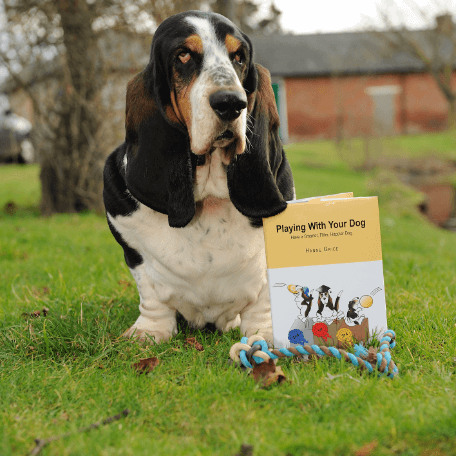
Get Hanne's Book
Playing With Your Dog will help any dog owner work out the games that are best suited for their pet to play throughout his life, from puppyhood to old age. The book also shares some tricks for all ages, group activities, and recommended toys that dogs will enjoy.
